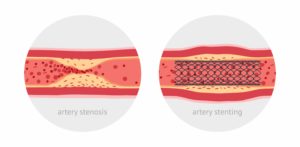Stent for coronary vessels
What is a stent?
A stent is used to keep open and dilate vessels and hollow organs. Strictly speaking, a stent stabilizes vessels after they have been dilated, especially in the coronary arteries.
Stents are used for many conditions involving vasoconstriction or occlusion of a blood vessel. This can be caused by arteriosclerosis or a blood platelet clot (thrombosis). When platelets get loose and clog vessels, it is called an embolism. The reason for this can be: Improper diet, poor exercise, obesity, high blood pressure, smoking, and also psychosomatic causes.
The blood flow can no longer flow properly due to the narrowing and blockage of the vessels, which can result in a stroke and a heart attack. It is mainly the coronary vessels where the so-called coronary stents are used. But other vessels can also be supplied with stents.
The metal mesh tube was widely used from the 1980s to the 1990s. In the beginning, a stent inserted coronary was simply an alloy of stainless steel. This is still the simple, classic and uncoated form.
How does stenting work?
Stenting is usually a minimally invasive procedure performed under local anesthesia. A cannula is inserted and the catheter is usually guided from the inguinal artery to the affected site with the help of a wire and placed there.
Preliminary examinations are necessary before the procedure (e.g. ECG, blood test, coronary angiography to visualize the vessels).
What are the risks of stent implantation ?
- hypersensitivity to the contrast agent
- cardiac arrhythmia
- stent thrombosis
- heart attack
- allergic reactions
- increased risk of bleeding when administering anticoagulant drugs
- thrombosis
- embolisms
- vascular injuries
What stents are available?
- self-deploying stents,
- The self-deploying stent consists of a steel mesh covered with plastic. After the surgeon has inserted the stent into the vasoconstriction with the aid of the catheter, the plastic cover is withdrawn and the stent can unfold to fit.
- balloon-expanding stents,
- In the balloon-expanding stent, the stent is attached to a balloon catheter, which is inserted and inflated during vasodilatation surgery – this is known as percutaneous transluminal angioplasty (PTA). The expanded shape of the metal mesh is maintained, and the catheter is pulled out. The stent then remains.
- coated stents
- When it was discovered, that inflammation or a new stenosis could form around the stents, coated stents were developed. These stents are coated with drugs that deliver their active ingredients to the surrounding cells.
- The following coated stents are available:
- antibody-coated stents (healing stents)
- drug eluting stents (DES)
The immunosuppressive drug sirolimus and the cancer therapy paclitaxel have proved particularly effective as active ingredients. Antibody-coated stents primarily prevent the risk of thrombosis after surgery. - radioactive stents
Since 1992, stents have also been exposed to deuteron bombardment or directly implanted as radioisotopes. This is intended to prevent overgrowth of cells in the inner skin vessels. Radioactive stents are not used to the same extent in all countries.
- bioresorbable stents,
Also known are the descriptions
- drug eluting stents (DES)
- bare metal stents (BES)
- bioabsorbable stents (BVS for bioabsorbalble scaffold)In 2012, absorbable stents were inserted for the first time, which dissolve by themselves after some time. The idea is that the vessel only needs to be supported for a while, and a stent is a foreign body.These so-called bio-stents are available in different types, and development is still ongoing. Materials that also have a role in the body’s metabolism, such as metallic glass, alloys of magnesium and of zinc or of rare earth metals, are mainly used. Lactic acid polymers are also used, which remain for about three to six months and degrade into water and carbon dioxide within two years.However, bio-stents have come under criticism in the past. According to studies, they are said to lead more frequently to stent thrombosis.

